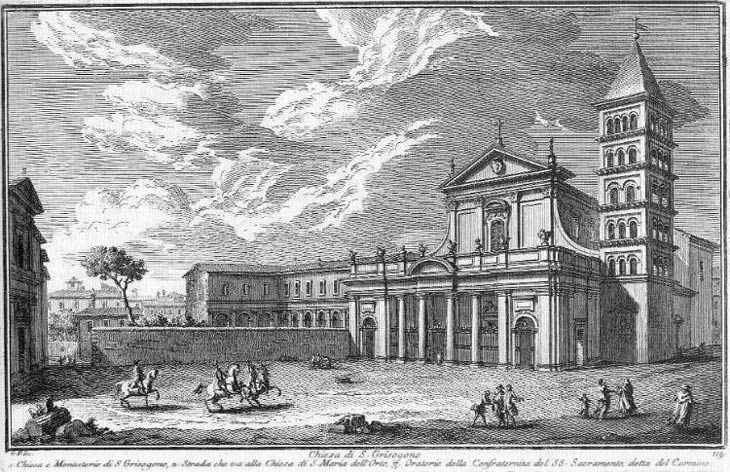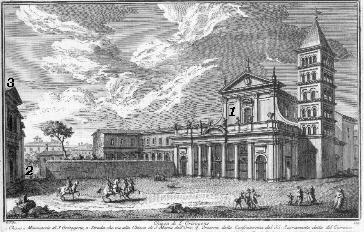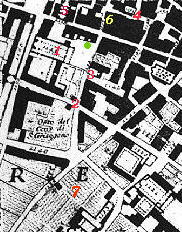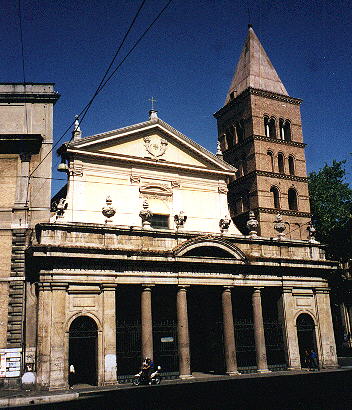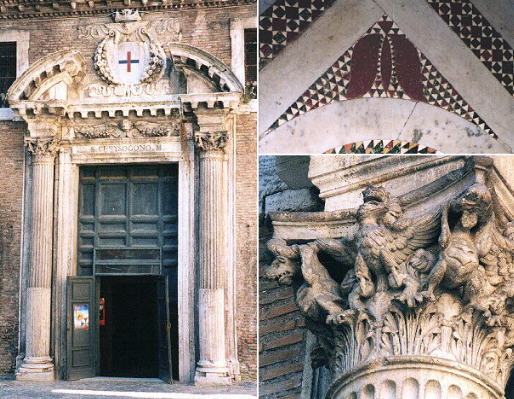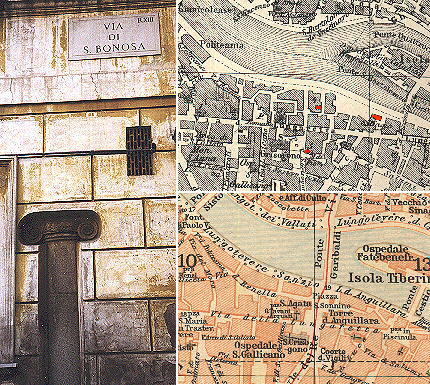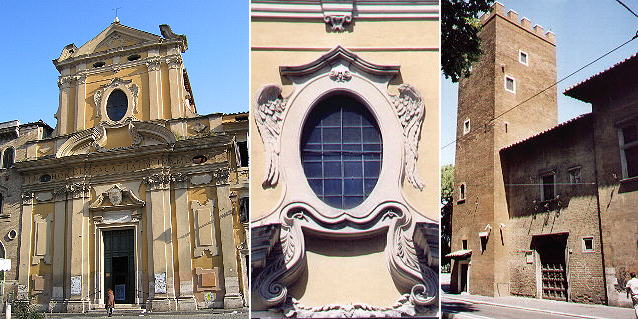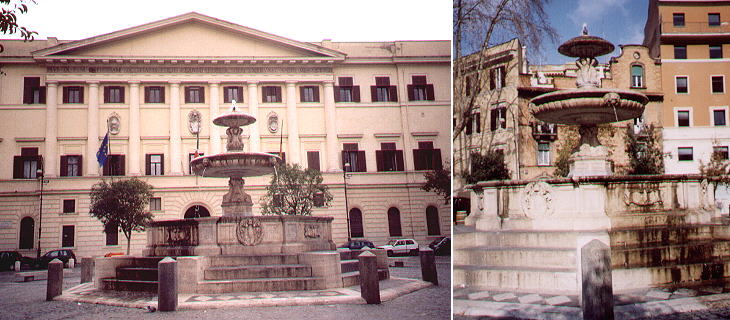

S. Grisogono (Book
6) (Map
C3) (Day 6) (View D10) (Rione Trastevere)
In this page:
The plate by Giuseppe Vasi
Today's view
S. Grisogono
S. Bonosa (and S. Eligio dei Sellai)
S. Agata in Trastevere e Torre degli Anguillara
Nuova Fabbrica del Tabacco
The Plate (No. 119)
S. Grisogono (today S. Crisogono) was the first major church of Trastevere
for those who crossed the river at Ponte Cestio and then walked along Via
della Lungaretta, the main street of Trastevere. The view is taken from the green dot in the small 1748 map here below.
In the description below the plate Vasi made reference to: 1) S. Grisogono;
2) Street leading to S. Maria dell'Orto; 3) Oratorio della Confraternita del SS. Sacramento.
The small map shows also 4) S. Bonosa; 5) S. Agata in Trastevere; 6) Torre degli Anguillara; 7) Nuova Fabbrica del Tabacco.
Today
The opening of Ponte Garibaldi and of Viale del Re (today Viale Trastevere)
has thrown the church right into the middle of today's life.
S.
Grisogono
The church goes back to the XIIth century and makes use of some Roman
columns, but it was widely restored in 1624 by Giovan Battista Soria for
Cardinal Scipione Borghese,
thus the eagles
and dragons of the Borghese are everywhere, even in the capitals of
the nice side entrance. S. Crisogono has a fine XIIIth century cosmatesque pavement.
S. Bonosa
The red spot marked with a 4 in the top map shows the site of the church dedicated
to S. Bonosa. The need to provide a better link between Trastevere and
the rest of the city led to the building of a new bridge (Ponte Garibaldi). The church was pulled down in 1888. A couple
of columns in the wall of a house next to the former site of the church belong to a medieval portico.
The red spot marked with a 3 shows the site of the oratory which was opposite S. Crisogono. The red spot near the river shows
the location of S. Eligio dei Sellai (farriers), a church which was pulled down in 1902.
S. Agata in Trastevere e Torre degli Anguillara
S. Agata was built in the XVIIth century on the site of an XIth century church having the same name.
The fašade (1712) by Giacomo Onorato Recalcati has several references to works by Francesco Borromini (in particular the role given to stucco decorations).
You may wish to attend the Procession of Madonna de Noantri which moves from S. Agata and reaches S. Crisogono.
The Anguillara, named after a fief they had near Bracciano, were a very prominent family in the XIVth and XVth centuries, but subsequently they lost their importance. They had their house-fortress in Trastevere. In the XIXth century the buildings were used as workshops for enamels and painted glasses.
Towards the end of the XIXth century the houses were largely modified and they were given an early Renaissance appearance and only the
tower retained its medieval looks.
Nuova Fabbrica del Tabacco
This imposing building with a colonnade above a high base has a vague resemblance to the Colonnade du Louvre in Paris.
The Latin inscription adds to its importance: PIUS IX P. (ontifex) M. (aximus) OFFICINAM NICOTIANIS FOLIIS ELABORANDIS A SOLO EXTRUXIT ANNO MDCCCLXIII.
It means that the building was a tobacco factory (Nicotianis foliis is a reference to the tobacco leaves introduced in Europe by the French diplomat Jean Nicot).
In 1863 Pius IX moved to this site the tobacco factory which had been located
near S. Maria dei Sette Dolori. The fountain at the centre of the square was built in the same period.
Excerpts from Giuseppe Vasi 1761 Itinerary related to this page:
Chiesa di s. Agata in Trastevere
Da Gregorio II. fu eretta quella chiesa l'anno 731. nella casa di sua madre, ed appresso
fecevi un monastero di monache, che vi stettero per alcuni secoli; ma passate queste
altrove, vi succederono alcuni Preti secolari; indi eretta la Congregazione de' Preti della
dottrina Cristiana, da Gregorio XIII. fu ad essi conceduta questa chiesa col monastero
annesso. Quasi incontro evvi la
Chiesa e Convento di s. Grisogono
PerchŔ non si sa di qual tempo sia la fondazione di questa magnifica chiesa, si crede
esser una di quelle edificate da' Fedeli in tempo di Costantino Magno, tantopi¨, che le
colonne della nave di mezzo mostrano essere state di vari tempj de' Gentili, perchŔ di
granito egizio, e ineguali di proporzione; e fu dedicata in onore di s. Stefano, di
s. Lorenzo, e di s. Grisogono. Da Gregorio III. fu notabilmente ristaurata: aggiungendovi
un monastero per li monaci venuti dall'Oriente in tempo della persecuzione delle sagre
Immagini; ed Ŕ notabile, che fra questi visse Stefano IV. mentre era giovine. Dopo i monaci
vi succederono i canonici di s. Salvatore, e nell' anno 1480. i frati Carmelitani della
congregazione di Mantova. Il Card. Gio. de Crema, essendone titolare, rinnov˛ la chiesa,
e poi il Card. Scipione Borghese la orn˛ con un prezioso ciborio, e col superbo soffitto
dorato, in cui si vede il santo Titolare dipinto dal Guercino da Cento. Incontro alla porta
maggiore evvi l'oratorio della confraternita del Carmine eretto nell'an. 1543. sotto
Paolo III. per associare il ss. Sacramento agl'Infermi. Indi camminando a destra, si trova
nel vicolo la
Chiesa di s. Bonosa
Piccola ma antica Ŕ questa chiesa eretta, come si crede, nella casa della santa Titolare.
Nell'anno 1480. volendosi rifare l'altare maggiore, fu trovato il corpo della Santa insieme
con altre reliquie; ottenuta poi dall'universitÓ de' Calzolari, vi aggiunse il titolo de
santi Crispino, e Crispiniano martiri.
|
Next plate in Book 6: S.
Giacomo a Scossacavalli
Next step in Day 6 itinerary: Ponte Sisto

Go
to  or to Book
6 or to my Home
Page on Baroque Rome or to my Home Page on Rome
in the footsteps of an XVIIIth century traveller.
or to Book
6 or to my Home
Page on Baroque Rome or to my Home Page on Rome
in the footsteps of an XVIIIth century traveller.
|


